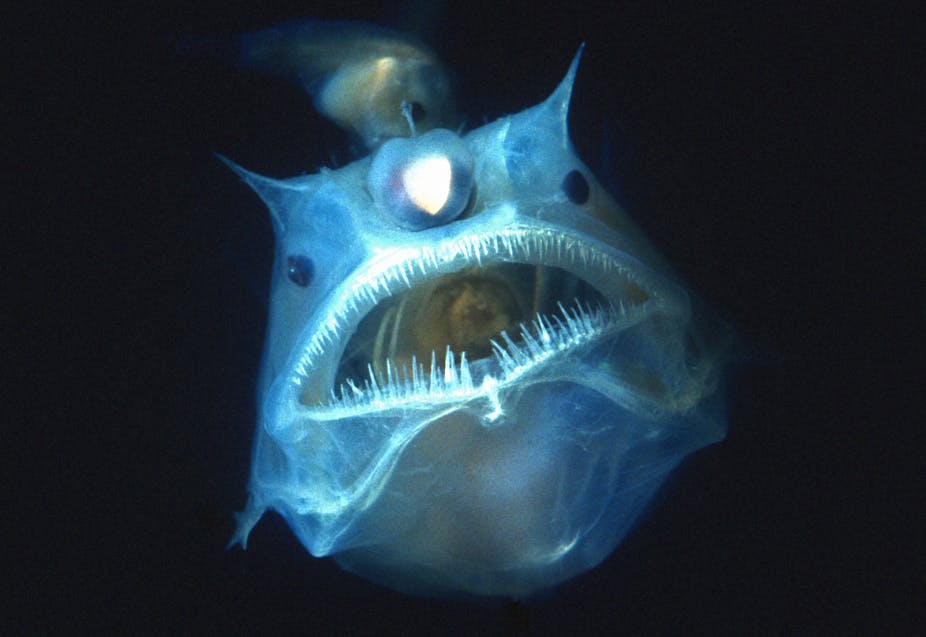
Curious Kids is a series by The Conversation, which gives children of all ages the chance to have their questions about the world answered by experts. All questions are welcome: you or an adult can send them – along with your name, age and town or city where you live – to curiouskids@theconversation.com. We won’t be able to answer every question, but we’ll do our best.
How do creatures living in the deep sea stay alive with the pressure? – Torben, age eight, Sussex, UK.
Hi Torben,
This is a great question – thank you so much for asking it. The deep sea is a very difficult place to live. There is no light, it’s cold, there’s not much oxygen and little food – and, as you rightly point out, the creatures that live there have to deal with the enormous pressure of the water above.
In the deepest part of the Atlantic, the pressure can be 840 bars – that’s about 840 times the pressure we experience at sea level. At Challenger Deep in the Mariana Trench – the very deepest part of all the world’s oceans – the pressure may be 1,000 bars or more.
But the creatures that live in the deepest parts of the ocean have special features, which help them deal with these tough conditions – including the crushing pressure.
Under pressure
When you dive to the bottom of a deep swimming pool, you might start getting a painful or unpleasant feeling in your ears and sinuses. This is because they contain air: that feeling comes from the air sacs in your body being squashed by the pressure of the water.
Fish living closer to the surface of the ocean may have a swim bladder – that’s a large organ with air in it, which helps them float up or sink down in the water. Deep sea fish don’t have these air sacs in their bodies, which means they don’t get crushed.
The deepest dwelling species of fish, called the hadal snailfish, can be found at depths of about 8,200m.
But having a body with no air cavities will only get you so far, since high pressure can also destroy the very structure of molecules – the tiny building blocks that make up all matter.
Read more: Curious Kids: is everything really made of molecules?
To help with this, deep sea creatures have “piezolytes” – small, organic molecules which have only recently been discovered. These piezolytes stop the other molecules in the creatures’ bodies, such as membranes and proteins, from being crushed by the pressure (though we’re not exactly sure how, yet).
Another interesting thing about piezolytes is that they give fish their “fishy” smell. Shallow water species have piezolytes too, but deep sea species have many more – so deep water species would smell much more fishy.
This molecule is only effective up to certain depths though; as the water gets deeper, the pressure becomes too much, even for snailfish. Tiny organisms called microbes have been recovered from the very bottom of the Mariana Trench, and they have peizolytes to help protect them, too.
Deep divers
While some animals live full time in the deep sea, others just visit. Species such as Cuvier’s beaked whale commute between the surface of the water, to breathe, and depths of over 2,000m, to feed.
These whales breathe air, but their lungs are collapsible, so they don’t get crushed when the whales dive into the deep sea for almost two hours at a time.
When diving, these whales store the oxygen from the air they breathe in their blood and muscles. They can do this because they have higher levels of haemoglobin and myoglobin molecules – which are used to store oxygen – than other whale species.
Cuvier’s beaked whales can also reduce their heart rate and temporarily stop the blood flowing to certain parts of the body, which helps the oxygen to last longer.
So, there are a few different ways creatures can survive in the deep sea, depending on whether they are just visiting, or live there all the time.
There’s one last thing to think about: it’s very difficult for scientists to study deep sea animals, as they tend to die when they are brought to the surface – so there might be many other remarkable features we don’t yet know about.
More Curious Kids articles, written by academic experts:


